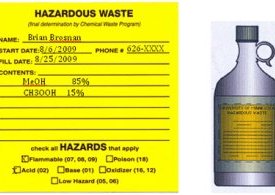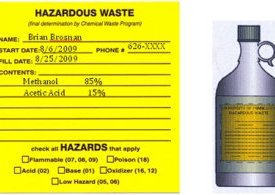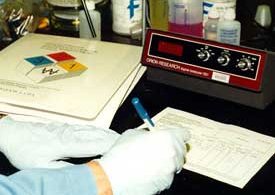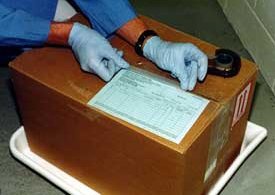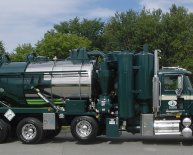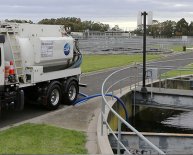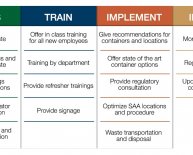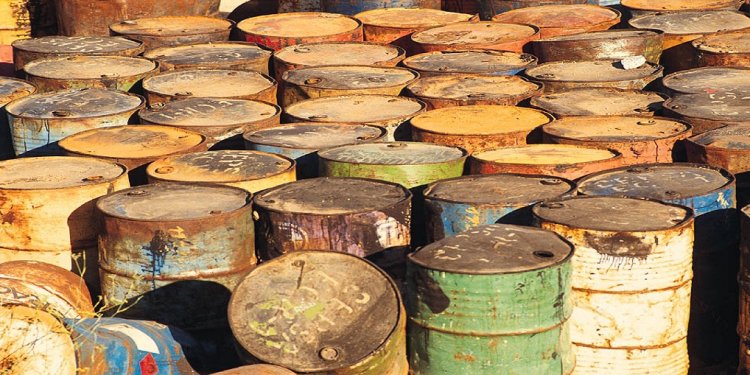
Hazardous Chemical Waste Disposal
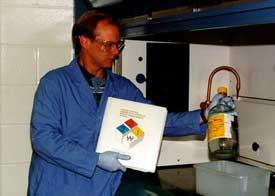
Introduction
This section provides guidelines for collecting, labeling, segregating, filling out a hazardous waste packing form, and packaging chemical waste. Waste disposal begins with the generator (shop or laboratory personnel) who first decides if the material is no longer needed. Materials which are no longer of use should not be considered waste until all other alternatives, such as redistribution or recovery, have been considered. If no pollution prevention options are available, follow the direction in this section to dispose of the chemical.
Where Does Your Waste Go?
Chemicals collected from your work area are transported to the University's Thompson Center for Environmental Management (TCEM). Here chemicals are sorted for recycling, redistribution, storage, treatment, and disposal.
Solvents or oils may be distilled for recovery, or collected in drums or tanks for storage. The stored solvents and oils will be fuel blended for heat recovery or incinerated.
Other chemicals are also collected in drums and sent to treatment facilities in and out of state. The majority of these chemicals are sorted into compatible groups and the original containers are placed into a "lab pack". A lab pack is a steel, plastic or fiber drum that contains the intact bottles of waste surrounded by cushioning absorbent material. After the lab pack is filled, the drum is shipped for recycling, treatment, or incinerations by a University-approved contractor.
Step 1. Evaluate the Waste
Fig 4-1: Collect waste in a proper, labeled container
Determine if your unwanted chemicals (whether pure or in mixtures) are listed in the Chemical Waste Registry (see Appendix I). If the chemicals are listed in the Registry and they do not have a nonhazardous designation ("xxNH" DDC number), then they must be managed as hazardous waste following the directions in this Guidebook (see the warnings regarding the disposal of nonhazardous chemicals in Part 1 and Part 2).
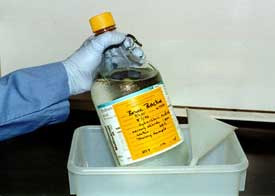 If the compounds in question are not listed in the Registry, or you have chemical mixtures, follow the detailed instructions in Step 6 - Complete the Hazardous Waste Packing Form of this Guidebook.
If the compounds in question are not listed in the Registry, or you have chemical mixtures, follow the detailed instructions in Step 6 - Complete the Hazardous Waste Packing Form of this Guidebook.
If in doubt, manage the chemicals as hazardous waste and send them to the Chemical Waste Program following the directions in this section.
Step 2. Collect the Waste
Fig 4-2: Keep containers closed (except when adding or
removing waste) and use secondary containment
Hazardous waste collection bottles must be kept capped, properly labeled, and stored in a safe location in the laboratory. Collection bottles and lids must be compatible with the chemicals stored in them. Bottles containing liquids should be stored with secondary containment, such as a plastic tray or safety cabinet. Drums should not be stored with an open bung or a funnel in them. Waste containers should be stored in appropriate locations, i.e. flammable liquid or acid storage cabinets. Click here for advice on closure for waste containers for HPLC and other analytical equipment.
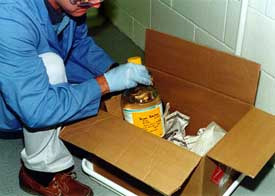 If containers larger than four liters in size are desirable for collecting the waste, obtain prior approval from the Chemical Waste Program. Call (612) 626-1604,
If containers larger than four liters in size are desirable for collecting the waste, obtain prior approval from the Chemical Waste Program. Call (612) 626-1604,
Package Chemical Waste for Collection in Appropriate Containers as Follows:
Screw cap bottles
Stoppered or corked flasks and bottles are unacceptable. The contents of these containers should be overpacked into or transferred to a screw cap bottle using a fume hood, proper protective equipment, and secondary containment. Keep in mind that both the bottle and screw cap must be chemically resistant to the waste chemical contained. Bottles with broken or cracked screw caps are also unacceptable. Note that there are exceptions to using screw cap bottles and some of these are listed below. If there are problems in transferring the waste to the suggested container for disposal, contact the Chemical Waste Program (612) 626-1604.
Exceptions to screw cap bottles: Overpacked containers
The following containers may be overpacked into a larger screw top bottle or a plastic bucket with secure lid and surrounded with an absorbent material such as vermiculite. The bucket must be labeled with the contents and amount of the enclosed container.
- Flasks with frozen stoppers of unknown substance
- Bottles containing unwanted hydrofluoric acid
- Glass sealed ampules with low boiling point chemicals
- Microcentrifuge tubes with snap caps or similar containers
- Contaminated glassware or powdered chemicals which are not in a proper containers should be packaged in sealed plastic bags, then overpacked and labeled.
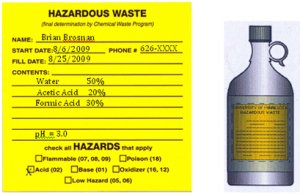 CAUTION: Wastes from different sources (i.e., reactions or processes) may react dangerously when mixed. Mixtures should be stored separately..
CAUTION: Wastes from different sources (i.e., reactions or processes) may react dangerously when mixed. Mixtures should be stored separately..
Step 3. Label the Waste Container
Fig 4-3: Package containers upright in a sturdy box with
n0 glass-on-glass contact
Bottles of waste must be labeled as they are generated in the laboratory or work area. Every bottle must be labeled in one of two ways:
Original Label
Unused or outdated chemicals that are in their original containers with labels identifying the contents are suitable for waste pickup by boxing the containers and affixing the pink copy of the hazardous waste form to the box. The completed waste form provides the words "Hazardous Waste" and the date. If the original label appears faded or illegible, affix a new label to the bottle.
To obtain the hazardous waste labels, call the Chemical Waste Program at (612) 624-6060.
Yellow Hazardous Waste Label
Regulation requires that hazardous, chemical waste containers are labeled with the words “Hazardous Waste” and a description that clearly identifies their contents to employees and emergency personnel. Containers of hazardous waste must be labeled as they are generated in the laboratory or work area.
Figure 4-7
Hazardous Waste Label
Collection bottles used for process wastes or mixtures of spent waste may use a Hazardous Waste Label supplied by the Chemical Waste Program (illustrated above) or a facsimile. The facsimile is required to have the words “Hazardous Waste” on the label. It must also have the contents in plain English OR use acronyms or formulas AND have the hazard class clearly identified on the label. Providing both as above is best practice.
To better comply with label requirements, we have modified the yellow Hazardous Waste Label so that the hazards of the waste are clearly identified by check box for emergency and non-lab personnel. When using this label, mark the check box for each Hazard that is applicable to the waste. Refer to the numeric portion of the DDC# for each constituent (see the Chemical Registry) to assist in assigning Hazards to the waste. Liquid wastes require constituent percentages and pH.
Hazard Class Codes (first two digits of DDC)
